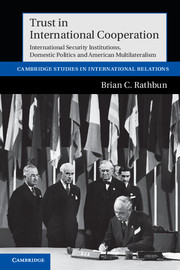 Trust in International Cooperation
Trust in International Cooperation Published online by Cambridge University Press: 05 June 2012
The League of Nations was a revolutionary attempt at international cooperation. Forever associated with its primary proponent, the American President Woodrow Wilson, the organization called on members to submit all of their disputes to some form of international conflict resolution before resorting to force and specified sanctions if they failed to comply. The institution's constitution, the Covenant, also contained a moral pledge promising that each member would come to the aid of other members so as to preserve their political independence and territorial integrity. The League's scope was to be global, encompassing most of the states of the world. The Covenant was negotiated with difficulty at the Versailles peace conference, only to be brought home by Wilson and defeated in the US Senate by those who believed it was a dangerous infringement of American sovereignty. The United States, whose president was the most strident advocate of the League of Nations, never joined. Ever since, scholars have contemplated the counterfactual of whether, had the United States been a part, the League for all its weaknesses might have served as an effective deterrent against Nazi aggression.
Rationalists have difficulty explaining Wilson's vision. Both in its dispute resolution mechanisms and its security guarantee, collective security rested on diffuse reciprocity among a large group of members with very different interests. Strategic trust cannot sustain qualitative multilateralism. Entrapment, abandonment and exploitation were all significant risks. Yet the Covenant bringing about the organization created no real supranational hierarchy to prevent opportunism. Lake concludes that for this reason it failed to garner the requisite American support in the Senate for ratification, but this begs several questions. How was Wilson able to make such a proposal in the first place and why did it garner such support in his Democratic Party? How could its supporters believe that the League would work? Rationalism also cannot account for why the League caused so much domestic division given that the primary opponents in the internal political struggle had the same set of interests and the same information.
To save this book to your Kindle, first ensure [email protected] is added to your Approved Personal Document E-mail List under your Personal Document Settings on the Manage Your Content and Devices page of your Amazon account. Then enter the ‘name’ part of your Kindle email address below. Find out more about saving to your Kindle.
Note you can select to save to either the @free.kindle.com or @kindle.com variations. ‘@free.kindle.com’ emails are free but can only be saved to your device when it is connected to wi-fi. ‘@kindle.com’ emails can be delivered even when you are not connected to wi-fi, but note that service fees apply.
Find out more about the Kindle Personal Document Service.
To save content items to your account, please confirm that you agree to abide by our usage policies. If this is the first time you use this feature, you will be asked to authorise Cambridge Core to connect with your account. Find out more about saving content to Dropbox.
To save content items to your account, please confirm that you agree to abide by our usage policies. If this is the first time you use this feature, you will be asked to authorise Cambridge Core to connect with your account. Find out more about saving content to Google Drive.